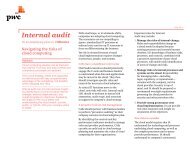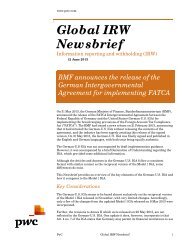A PRACTITIONER'S GUIDE TO BASEL III AND BEYOND - PwC
A PRACTITIONER'S GUIDE TO BASEL III AND BEYOND - PwC
A PRACTITIONER'S GUIDE TO BASEL III AND BEYOND - PwC
- No tags were found...
You also want an ePaper? Increase the reach of your titles
YUMPU automatically turns print PDFs into web optimized ePapers that Google loves.
A Practitioner’s Guide to Basel <strong>III</strong> and Beyond123n4567891012345678920123456789301234567894041x243 xx3.6 New minimum capital ratios 783.7 Contingent capital 803.8 The capital buffers 813.9 Practical considerations 823.10 Superequivalence 853.11 Conclusion 864 Trading Book and Securitisation 89Ina de Vry4.1 Introduction 894.2 The Standardised Approach to marketrisk capital 904.3 The internal model approach to marketrisk capital 924.4 The Basel II review of the trading bookin 2005 934.5 The effect of the crisis 944.6 Basel II.5 and Basel <strong>III</strong> changes 974.7 Market risk – looking forward 1165 Counterparty Credit Risk 121Monika Mars and Agatha Pontiki5.1 Introduction 1215.2 Overview of counterparty credit risk 1215.3 Proposals to enhance counterparty creditrisk capture 1265.4 Implications and practicalities 1416 Liquidity and Funding 147Charlie Beach and Claire Rieger6.1 Introduction 1476.2 Basel <strong>III</strong> regulations 1536.3 Implications and practical issues 1697 Leverage 181Fernando de la Mora7.1 Introduction 1817.2 Background 182
A Practitioner’s Guide to Basel <strong>III</strong> and Beyond12 Disclosures and Pillar 3 285Christophe Cadiou123n4567891012345678920123456789301234567894041x243 xxii12.1 Introduction 28512.2 Overview of risk disclosure requirements 28812.3 Practical implementation challenges 30712.4 Conclusion – the future of riskmanagement disclosures 31213 Taxation 315Matthew Barling and Anne-Marie Stomeo13.1 Introduction 31513.2 The taxation environment for banks 31513.3 Tax implications of Basel <strong>III</strong> proposals 32213.4 Conclusion 33114 Reward 333Tom Gosling14.1 Introduction 33314.2 Forces for change 33314.3 Incorporating risk into performancemeasures 33714.4 Design of compensation 34814.5 Governance of remuneration 35614.6 Disclosure of remuneration 36214.7 Conclusion 36415 Recovery and Resolution Planning 367Duncan McNab15.1 Introduction – in peace plan for war 36715.2 International overview 36915.3 Recovery – financial Business ContinuityPlanning 37415.4 Resolution – planning for your own funeral 37915.5 Reality check – lessons learned from the pilots 38315.6 Conclusion 384
Contents16 Stakeholder Perspectives 387Richard Barfield16.1 Introduction 38716.2 The funding spectrum 38716.3 Equity investors 38916.4 Debt investors and contingent capital 39316.5 Depositors and borrowers 39616.6 Government and the taxpayer 39916.7 Rating agencies 40216.8 Transparency for stakeholders 40416.9 Conclusion 40717 Implications for Risk Management 409Sonja du Plessis17.1 Introduction 40917.2 Establishing an explicit risk culture 41217.3 Role of the board 41517.4 Risk appetite 42117.5 Chief risk officer 42417.6 Conclusion 43418 Implications for the Economy 437Nick Forrest18.1 Introduction 43718.2 How banks (and banking regulations)impact the economy 44118.3 Likely response of banks 45018.4 Impact of previous regulatory changes 45218.5 Impact on the broader economy 45418.6 Conclusion 46619 Implications for Supervision 469Patrick Fell19.1 Introduction 46919.2 The core principles 47119.3 Rethinking supervision 47519.4 New style supervision – the glide path 476xxiii123n456789101234567892012345678930123456789401243
A Practitioner’s Guide to Basel <strong>III</strong> and Beyond123n4567891012345678920123456789301234567894041x243 xxiv19.5 Key principles for macro-prudentialsupervision 47919.6 Will the authorities be able to meet theexpectations placed on them? 48219.7 The place of the regulator 49219.8 International oversight 49419.9 Conclusion 498Appendix I – Trends in Pillar 3 reporting and riskdisclosures 501Appendix II – List of banks covered in the analysisof Pillar 3 and risk managementdisclosures 511Appendix <strong>III</strong> – CEBS observed good practices fordisclosures on activities affected bythe market turmoil (with mapping tothe SSG leading practices) 513Index 519
Chapter 1IntroductionRichard Barfield1.1 OverviewBasel <strong>III</strong> represents the biggest regulatory change that thebanking industry has seen in decades. It is salutary to rememberthat it is only one, albeit very important, component of a suite ofrelated reforms that are changing banking, regulation, supervisionand the relationship between banks and the state.In November 2010 the G20 ratified the Basel Committee’sproposals for strengthening capital and liquidity standards. Indoing so, they committed the global banking industry to significantchange and a transition period that extends beyond 2020.Distant deadlines have the danger of creating complacency andinaction. Leading banks recognise this threat and have no desireto suffer the same fate as the apocryphal simmering frog. Themarket is also asking how banks will be impacted. The questionthen, is what practical actions should banks be taking? ThisGuide aims to provide some answers.To set the scene, this Chapter introduces Basel <strong>III</strong>, the reformlandscape, the key players, and provides an overview ofthe Guide.1.2 For whom is the Guide intended?This is a Practitioner’s Guide to the potential implications ofBasel <strong>III</strong> and beyond: we go beyond the text of the new Baselguidance to consider implications and practical implementationissues. The Guide also goes beyond Basel <strong>III</strong> to consider closely1
A Practitioner’s Guide to Basel <strong>III</strong> and Beyondrelated reforms such as changes to recovery and resolution(what banks should do when they are at risk of failing or whenthey have failed). This is therefore a Practitioner’s Guide thataims to address the new realities.The Guide is intended to have broad appeal; the types of readerthat we had in mind when putting finger to keyboard includedfor example:(a)(b)(c)CEOs and directors wanting to understand the importantparts of the G20 reform agenda and its consequences forfinancial institutions;CFOs, CROs, Compliance Officers, Treasurers, and COOsgrappling with managing one of the most complex changeagendas in history; andsupervisors and legal advisers looking for a rounded andcoherent overview of Basel <strong>III</strong> and insights into what itmight mean for banks.1.3 Overview of the reform agendaIt is important to put Basel <strong>III</strong> in context. The G20’s main aimon banking reform is to ensure that governments never againhave to bail out the sector. They want to remove the implicitguarantee that governments will back large banks if they get intotrouble. The G20 does not want to eradicate bank failure nor doesit expect central banks never to have to provide liquidity supportto troubled firms, but the G20 is absolutely clear that bankdependencyon taxpayer support on the scale witnessed over thelast three years is unacceptable and must not be repeated.The clarity and unity of purpose of the G20 on the issue is unparalleled.Recent events in Ireland, Greece and Portugal illustratethe importance of achieving this goal. However, for it to happen,that unity of purpose will need to be sustained for a long time.xThe causes of the global financial crisis were complex and,because of the interconnectedness of the financial system, itsimpact was felt far and wide. However, it did not affect all banksor all economies in the same way. Several countries’ banksemerged unscathed. Asia generally, Australia, Brazil, Russia,2
IntroductionCanada and South Africa are some notable examples. This is whythe G20’s unity is remarkable, but unity it has been nonetheless.Given that the Financial Stability Forum (“FSF”) was born at theG7 Finance Ministers’ meeting in the wake of the Asian financialcrisis of 1999, perhaps we should not be so surprised. Since then,the G7 grouping has grown in both number and scope. Inresponse to the 2007 financial crisis, G20 summits involvingheads of state were convened. The summits were preceded bymeetings of the G20 Finance Ministers and Central BankGovernors. The G20 was designated the premier forum for internationaleconomic cooperation at the Pittsburgh G20 summit in2009, formally superseding the G7. In the same year, theFinancial Stability Board (“FSB”) superseded the FSF.Since the crisis, a plethora of reforms have been proposed froma wide variety of sources, not just the Basel Committee. Theseincluded the FSB’s proposals on reward; the EuropeanCommission’s proposals on governance in financial institutions;bank levies proposed globally and locally; and taxes onbankers’ bonuses etc. Figure 1.1 gives an idea of the range andcomplexity of reform that is being pursued. The Basel proposalsare one item on this list.Figure 1.1 The reform agendaThe reform agendaBasel II.5 and Basel <strong>III</strong>Pre–funding of deposit insuranceResolution fundWholesale levyProvisions and other accountingchangesSubsidiarisationCentral counterparty clearing(OTC contracts)Reporting (capital and liquidity)supervision/oversightRemunerationNarrow banking“Glass–Steagall II”Product market regulationPro-consumer regulationRole of credit rating agenciesSecuritisation marketsFund managers to improve fundliquidityHedge fund regulationBank risk management and governanceMacro-prudentialSupervisory approachCross–border collegesRecovery and resolution3
A Practitioner’s Guide to Basel <strong>III</strong> and BeyondTo give one example of the scale of other reforms: in the US, theDodd-Frank Act was signed into law on 21 July 2010 and has2,319 pages (by contrast the 1933 Glass-Steagall Act had a mere37 pages). The remarkable thing is that the Dodd-Frank Act isjust the beginning. Ten US regulatory agencies are now puttingthe detailed regulatory flesh on the bare legislative bones.As the devils lie in the detail, the final consequences ofDodd-Frank may be unclear for years to come. And, of course,Dodd-Frank does not cover everything in Figure 1.1.The scope of reforms addressed in other countries may, in somecases, be similar in breadth to the reforms brought about byDodd-Frank, but these will vary according to local context,history, experience of the crisis, existing central bank and regulatoryframeworks etc.The impact of Basel <strong>III</strong> in each country will also need to be placedin the context of the local reform agenda. For example, in theEuropean Union, Solvency II (which sets out strengthened riskmanagement and capital adequacy requirements for insurancefirms) is being introduced with a proposed “go-live” date of1 January 2013. This parallel development may have impacts onbanks, for example in the availability and pricing of mediumtermfunding.There are also much bigger forces at play. There is the rebalancingof the world economic order to the East and the South,large government deficits in several Organisation for EconomicCooperation and Development (“OECD”) economies,persistent trade imbalances and mis-valued currencies. Thismeans that reforms are being introduced in “interesting times”.1.4 The playersxSo, who are the main players in shaping the reform agenda?The G20 sponsors the FSB whose central goals are to improvethe functioning of financial markets and to maintain financialstability through coordinating the work of national financialbodies and promoting effective regulatory, supervisory andother financial sector policies.4
IntroductionThe Basel Committee on Banking Supervision (the “Committee”or “BCBS”) is one of the 42 FSB members and the centralforum for regular cooperation on banking supervisory matters.It takes its name from the Swiss border town where its secretariatis based. This is also where Committee members, seniorofficials responsible for banking supervision or financialstability issues, meet. The members come from central banksand other authorities with formal responsibility for the prudentialsupervision of banking. Over recent years, it has developedincreasingly into a standard-setting body on all aspects ofbanking supervision. At the time of writing (March 2011), theChairman of the Committee is Mr Nout Wellink, President ofthe Netherlands Bank.The countries represented on the Basel Committee are:Argentina, Australia, Belgium, Brazil, Canada, China, France,Germany, Hong Kong, India, Indonesia, Italy, Japan, Korea,Luxembourg, Mexico, the Netherlands, Russia, Saudi Arabia,Singapore, South Africa, Spain, Sweden, Switzerland, Turkey,the United Kingdom and the United States.The BCBS reports to a joint committee of central bank governorsand heads of supervision (GHOS) from its member countries.The GHOS debates and approves the Committee’s recommendationsbefore they are issued.As the reader can see, there is overlap between GHOS membershipand G20 finance ministers and central bank governors. SeeFigure 1.2As one would expect, the BCBS is supported by a number ofexpert committees (see Figure 1.3). From the point of view ofBasel <strong>III</strong>, the most important of these is now the StandardsImplementation Group which concentrates on the implementationof Basel standards and guidance, and, as of March 2011, ischaired by José María Roldán.It is useful to draw a distinction between regulation and supervision.Regulation is the set of rules and standards that governfinancial institutions; supervision is the process designed tooversee financial institutions to ensure that the rules and5
A Practitioner’s Guide to Basel <strong>III</strong> and BeyondFigure 1.2 The playersstandards are applied. In some countries, these two activitiesare performed by separate bodies (e.g. China, Germany andSwitzerland) and in many by different parts of the same organisation(e.g. Reserve Bank of India, South African ReserveBank and the Monetary Authority of Singapore). In the UK, theBank of England and the FSA are represented on the BaselCommittee, but the FSA’s responsibilities for prudential supervisionwill soon become part of the Bank of England. It shouldbe clear to the reader that regulation, supervision and financialstability are often closely interlinked.xAnother important stakeholder group is the banks themselves.In some countries, criticising banks has long been a nationalsport and in others the crisis gave criticising banks a muchneededboost. Politicians, previously cheerleaders of the creditfuelledboom, were, in the natural way of things, not slow in6
IntroductionFigure 1.3 The Basel Committee structurechanging their position. As a result of unrelenting bad press insome countries, it is sometimes easy to forget the critical rolethat banks play in international trade, financial intermediation(linking providers of finance with those that need it) and theeconomy as a whole. Their participation in the reform debatehas also been very important to provide input to finance ministers,central bankers, regulators and their staff to give insightsinto how the reforms might impact banks and what the widereconomic consequences might be.In most countries there are trade associations of banks (the BritishBankers’ Association, for example). These play an important roleat national level. However, the only global association of financialinstitutions is the Institute of International Finance (“IIF”). Likethe G7 it was born of crisis and was created in 1983 by banks inthe wake of the international debt crisis of the early 1980s. The IIFnow has over 400 financial institutions as members. Its mission isto support the industry in managing risk, develop best practicesand standards for the industry, advocate policies that are in thebroad interests of members and foster global financial stability.7
A Practitioner’s Guide to Basel <strong>III</strong> and Beyond1.5 A brief history of BaselGlobal standards for capital are a relatively recent innovation.Basel I came into force in 1988, related only to credit risk, andwas relatively simple. Before then, there were no standardisedrules on capital adequacy for banks. In 1996, market risk ruleswere added. In December 1998, the BCBS recognised that BaselI needed to be revised to reflect credit risk more effectively andto prevent increasing use of arbitrage by the banks that wereusing more and more sophisticated internal models to measureand understand risk. The Committee also decided to recommenda capital charge for operational risk.Basel II was born and took five years to develop and then afurther four years to implement. Basel II has only been in placesince January 2007 (or 2008 for those on the advancedapproaches under Basel II: credit risk regulatory requirementsmay be calculated using one of three methods which are, inincreasing order of sophistication, the Standardised Approach(“SA”); the Foundation Internal Ratings Based approach(“FIRB”); and, Advanced Internal Ratings-Based approach(“AIRB”). Most large international banks use AIRB for themajority of their exposures). In some countries it had not beenimplemented when the crisis hit (for example the US). Figure1.4 provides the timeline.Figure 1.4 Brief history of Basel I and Basel IIx8
The Committee’s remit extends a long way beyond capitaladequacy. Its other global standards and consultations include,for example, liquidity risk, deposit insurance, risk management,corporate governance, stress testing and alignment of riskand reward.The Committee’s conclusions and recommendations do nothave legal force: its role is to formulate supervisory standardsand guidelines. It recommends best practices in the expectationthat individual authorities will implement them throughdetailed national arrangements – statutory or otherwise – whichare best suited to their own national systems. The Committeeencourages convergence towards common approaches and standardswithout attempting detailed harmonisation of membercountries’ supervisory techniques. Even in the EU where Basel<strong>III</strong> will be enshrined in version four of the Capital RequirementsDirective (“CRD”), there are likely to be some differences innational interpretation and implementation.1.6 Basel <strong>III</strong> in a nutshellIntroductionThe main aim of Basel <strong>III</strong> is to improve financial stability. Viewson the causes of the financial crisis are well (and extensively)documented. Commentators still argue over some aspects butthere is consensus on the key issues. The Report of the deLarosiere Group on the future of European regulation andsupervision, published in February 2009 (Report, the high-levelgroup on financial supervision in the EU, chaired by Jacques deLarosiere, 25 February 2009), was an early and excellent contributionthat succinctly identified the principal causes of thefinancial crisis and made detailed recommendations for reformwithin the European system and globally.Before the crisis, there was a period of excess liquidity. As aresult liquidity risk had, for many banks and supervisors,become practically invisible. When liquidity became scarce(particularly as wholesale funding dried up) as the crisis developed,banks found that they had insufficient liquidity reservesto meet their obligations.9
A Practitioner’s Guide to Basel <strong>III</strong> and BeyondAlso, banks had insufficient good quality (i.e. loss absorbing)capital. Low inflation and low returns had led investors to seekever more risk to generate returns. This led to increasedleverage and riskier financial products. High leverage amplifiedlosses as banks tried to sell assets into falling and shrinkingmarkets, which created a vicious circle of reducing capitalratios and a need to de-lever, which increased asset disposals.Mark-to-market accounting meant that there was no hidingplace as buyers disappeared, prices dropped and trading assetvaluations plummeted.Due to a lack of transparency, counterparty credit risk wasmisunderstood and risk concentrations were underestimated.The interconnectedness of the financial system meant that, whentrading counterparties defaulted, the shocks were transmittedrapidly through the system; the necessary shock absorbers werenot in place, nor was transparency over the linkages.To make matters worse, the Basel II capital formulae forcredit risk are “procyclical”. This means that as a downturndevelops the probability of borrower default and loss atdefault both increase, which means that regulatory capitalrequirements increase. This should be dealt with throughPillar 2 capital planning buffers but the risks had beenunderestimated by banks and supervisors alike. Under Basel II,Pillar 1 calculates the minimum regulatory capital requirementsfor credit, market and operational risk; Pillar 2 covers thesupervisory review process where supervisors evaluatewhether banks should hold more capital than the Pillar 1minimum; and Pillar 3 aims to encourage market disciplineby specifying disclosure requirements to be made by banks tothe market.All the above meant that banks had to turn to their centralbanks for liquidity support and some to their governments forcapital injections or support in dealing with assets of uncertainvalue for which there were no other buyers. Several majorinstitutions are still dependent on state (i.e. taxpayer) support.xIn response to the crisis, the Basel proposals have five mainobjectives:10
Introduction(1) raise the quality, quantity, consistency and transparency ofthe capital base to ensure that banks are in a better positionto absorb losses;(2) strengthen risk coverage of the capital framework bystrengthening the capital requirements for counterpartycredit risk exposures;(3) introduce a leverage ratio as a supplementary measure tothe Basel II risk-based capital;(4) introduce a series of measures to promote the build-up ofcapital buffers in good times that can be drawn upon inperiods of stress. Linked to this, the Committee is encouragingthe accounting bodies to adopt an expected lossprovisioning model to recognise losses sooner; and(5) set a global minimum liquidity standard for internationallyactive banks that includes a 30-day liquidity coverage ratiorequirement, underpinned by a longer-term structuralliquidity ratio.The Basel changes discussed in this Guide are embodied inBasel II.5 and Basel <strong>III</strong>. The evolution from Basel I to Basel <strong>III</strong> isshown in Figure 1.5. Overall there are nine elements to the Baselchanges which the Guide covers as follows:(a) Capital definition (Chapter 3) – item 2 in Figure 1.5(b) Higher minimum ratios (Chapter 3) – item 3(c) Trading book and securitisation – Basel II.5 (Chapter 4) –item 1(d) Counterparty risk (Chapter 5) – item 7(e) Liquidity Coverage Ratio (Chapter 6) – item 8(f) Net Stable Funding Ratio (Chapter 6) – item 9(g) Leverage ratio (Chapter 7) – item 4(h) Conservation and countercyclical buffers (Chapter 9) –item 5(i) Systemic risk (Chapter 15) – item 6Basel II.5 refers to guidance that was issued in July 2009(“Revisions to Basel II market risk framework”). It includedadditional capital requirements for the trading book and revisionsto the treatment of securitisations that come into effect on1 January 2012. Basel <strong>III</strong> also goes further and recommendschanges to Pillar 2 (banks’ internal assessment of capital11
A Practitioner’s Guide to Basel <strong>III</strong> and BeyondFigure 1.5 Basel evolutionrequirements and supervisory review of risk management andcapital assessment) and Pillar 3 (market discipline). TheCommittee provides additional guidance on key areas toconsider as part of Pillar 2 (e.g. risk concentrations): these wereexpected to be implemented immediately. On Pillar 3, theCommittee reiterates banks’ responsibility to make sure thattheir disclosures to market participants evolve to keep upwith changes in their risk profile. The Committee alsomakes detailed recommendations regarding, for example, thedisclosure of traded securitisations.Given the scale of change being proposed in Basel <strong>III</strong>,the Committee has agreed a lengthy transition period (seeFigure 1.6). All but the phasing out of certain capitalinstruments will be in place by 1 January 2019. The phasingout of capital instruments, such as hybrids and Tier 2 instrumentsthat will no longer qualify will be completed by 1January 2022. After 1 January 2013, new issues of capital instrumentsthat do not qualify as common Tier 1 equity willbe required to include a conversion feature, making themcontingent capital.xFor the leverage ratio, the Liquidity Coverage Ratio and theNet Stable Funding Ratio, observation periods will be usedto monitor carefully how the new measures will work12
IntroductionFigure 1.6 The transition to Basel <strong>III</strong>before they are phased in. Given the speed with whichagreement was reached on Basel <strong>III</strong>, it is likely that we willsee some changes as the consequences and implementationchallenges become better understood through the transitionperiod.1.7 Coverage of the GuideIn Chapter 2 we consider the big picture: the strategic contextinto which Basel <strong>III</strong> and other reforms are being introduced.This Chapter considers questions such as: what are the keytrends and challenges facing banking? What will Basel <strong>III</strong>mean for business models and bank management? Is Basel <strong>III</strong>likely to achieve its intended consequences and what is therisk of unexpected outcomes? The first step in Basel <strong>III</strong> is toprovide a tighter definition of regulatory capital. This is needed toaddress the issue that not all Tier 1 regulatory capital proved tobe loss-bearing (e.g. preference shares). The Committee alsoagreed that the rules regarding the definition of availablecapital resources needed to be sharpened. Chapter 3 examines indetail the definition of capital and discusses the implications forbanks.13
A Practitioner’s Guide to Basel <strong>III</strong> and BeyondThe requirements to hold capital have also changed. Riskweightedassets (“RWA”) have increased through Basel II.5 forthe trading book and securitisations and through Basel <strong>III</strong>for counterparty credit risk. Chapter 4 covers this aspect ofBasel II.5 while Chapter 5 discusses the new treatment for counterpartycredit risk. These reforms will have a major impact oninvestment banks and the funding of financial institutions.The effect of tougher definitions of capital and increasedRWA is to make a 1 per cent Tier 1 ratio under Basel <strong>III</strong> a lotmore expensive than under Basel II (see Figure 1.7). The BaselQuantitative Impact Study (“QIS”) published in December 2010estimated that for Group 1 banks (defined by the BaselCommittee as those with Tier 1 capital in excess of €3 billionthat are well diversified and internationally active; all otherbanks are classified as Group 2. The QIS covered 91 Group 1banks, 74 of which provided the relevant data), double theamount of capital would be required under Basel <strong>III</strong> due to thetighter definition of capital and the increase in RWA (before anyincrease in minimum ratios or the impact of the leverage ratio).As one can see, this will depress return on equity and is likelyto fundamentally change investors’ perceptions of banks.Figure 1.7 New money, old moneyx14
IntroductionOn top of this devaluation, the minimum ratio for commonequity more than trebles from 2 per cent to 7 per cent(a minimum of 4.5 per cent plus a conservation buffer of2.5 per cent). Together these figures imply about a seven-foldincrease in Basel minimum capital requirements. Note that thisis before the countercyclical buffer and any addition forSystemically Important Financial Institutions (“SIFIs”).A major innovation in Basel <strong>III</strong> is the introduction of globalliquidity standards. Basel <strong>III</strong> introduces a “Basel I” for liquidityfor the first time. This has two aspects: a Liquidity CoverageRatio (“LCR”) and a Net Stable Funding Ratio (“NSFR”). TheLCR aims to make sure that banks hold a defined buffer to allowthem to be self-sufficient for up to 30 days should a bank-specificstress event and a market downturn occur at the same time. TheNSFR takes a longer view and aims to encourage banks to bettermatch the funding characteristics of their assets and liabilitiesbeyond a one year period. The NSFR will reduce the amount of“maturity transformation” provided by the financial sector (theability of banks to borrow short and lend long). Chapter 6discusses how the NSFR is likely to work in practice.The BCBS approach to leverage builds on approaches in use insome countries already (for example the US, Switzerland andCanada). As with liquidity, a global standard is being set for thefirst time. Chapter 7 assesses this new measure which couldhave implications for several banks’ business models.Chapter 8 investigates the implications of changes to IFRS andUS GAAP. The standard-setters are under pressure to introducereforms that will eliminate the worst procyclical effects of thecurrent accounting rules. A significant change to the way provisioningis undertaken is expected. This is just one of a series ofmajor changes to financial reporting that will be introducedover the next few years. Together with the developments inPillar 3 reporting these changes pose a significant operationalchallenge for banks.The impact of Basel <strong>III</strong> on Pillar 2 is discussed in Chapter 9together with capital planning and the interaction of the newcapital buffers: the conservation and countercyclical capital15
A Practitioner’s Guide to Basel <strong>III</strong> and Beyondbuffers. The qualitative aspects of Pillar 2 – risk managementand managing risks that are not captured in Pillar 1 – are areaswhere greater supervisory attention is likely to be focussed.Chapter 10 discusses the reforms to the procyclical componentsof the Basel rules. Procyclicality – the tendency of capitalrequirements to increase in a downturn and decrease in anupturn – is a fundamental feature of risk-based capitalrequirements but is probably one of the least understood. ThisChapter examines the nature of procyclicality in Pillar 1 capitalrequirements and modelling (which affects both Standardisedand Advanced banks), and the proposed “dampeners” of provisioningand capital buffers.Stress testing is a key tool to understanding emerging risks andcapital requirements over the cycle. Supervisors are increasinglyusing supervisor-determined stresses to evaluate therelative riskiness of institutions. At the end of 2010, the FederalReserve required the larger US banks to undertake stressesbefore it would approve distributions in dividends andbonuses. The European Banking Authority and its predecessor,the Committee for European Banking Supervisors, haveconducted European-wide stress tests in 2010 and 2011. Thesehave proved to be very challenging exercises for banks andsupervisors. Chapter 11 examines recent developments inleading industry practices for stress testing.Chapter 12 reviews developments in Pillar 3 for disclosures tomarket participants. Lack of transparency has been identified asa contributing factor to the crisis and Basel aims to strengthenthe market discipline embodied in Pillar 3 by requiring greaterdisclosures from the banks, many of whom have already begunto do this.xNo discussion of capital reforms would be complete withoutconsidering the tax implications which are addressed inChapter 13. In particular, the removal of deferred tax assets as asource of capital for banks that are going concerns has seriousconsequences for certain banks in certain jurisdictions. Thiswill have consequences, amongst other things, for structure,domicile and funds transfer pricing. Tax is also closely linked16
Introductionto the entity structure of financial institutions which is alsounder the magnifying glass as part of addressing recovery andresolution plans (see Chapter 15).Probably one of the most emotive topics in the reform of thebanking system is the subject of bankers’ pay – or rather the highbonus pay of a relatively small number of bankers. To influencebank management, supervisors are focussing intently on thelinks between risk and reward and wish to make sure that banksare not offering incentives that would conflict with the goal ofincreasing financial stability. Chapter 14 delves into leadingpractice in this critically important and rapidly evolving area.Planning your own funeral is how resolution plans have beendescribed. Chapter 15 addresses this important and difficultsubject. In the wake of the difficulties surrounding the windingup of Lehman, this is the push for banks to develop contingencyplans that can be invoked in the event of a future crisis. Recoveryrefers to contingency plans that need to be deployed whensurvival is not at stake. These are particularly important forSIFIs, which may be systemically important from either alocal or global perspective. SIFIs without sound recovery andresolution plans can expect capital and liquidity surcharges.The detailed recommendations on SIFIs are expected laterin 2011.In Chapter 16 we consider the perspectives of other stakeholders:equity investors, debt investors, government and ratingagencies. Regulators seem to have a tendency to ignore theinconvenient question of supply of capital and the interests ofcapital providers. For example, Mervyn King, the Governor ofthe Bank of England, in a speech to leading economists, questionedwhy bankers should be concerned about return on equity(“Banking: from Bagehot to Basel and Back Again”, the SecondBagehot Lecture, 25 October 2010). However, for the system tooperate effectively, the interests of investors cannot be ignored:this Chapter discusses reform from their perspectives and fromthose of other stakeholders beyond banks and regulators.A key response to the crisis has been strengthened risk managementin banks. Chapter 17 examines the implications of reforms17
A Practitioner’s Guide to Basel <strong>III</strong> and Beyondfor governance, risk management and the role of the CRO.Improved bank risk management is, in our view, likely to be asimportant a contributor to financial stability as higher capitalratios. It will be central to strengthening the industry and itsability to respond to future challenges.Too rapid an introduction of reforms such as Basel <strong>III</strong> in a kneejerkresponse to the crisis could cause banks to reduce theamount of credit available and/or increase its price (to achievethe new capital ratios or to pay for the additional capital andliquidity). In turn, this could harm the economy and somesectors would be worse hit than others. Chapter 18 considerslikely bank responses to, for example, higher capital requirementsand the potential macro-economic implications.Last but not least, Chapter 19 examines the initiatives that arebeing taken to improve banking supervision. This is one of theareas of reform where small investments could reap enormousdividends if the investments are made wisely. It is also an areawhere the challenge of achieving international consensus andmaintaining a reasonably level playing field is potentially amajor obstacle to the successful implementation of Basel <strong>III</strong>.1.8 Looking forwardMuch still needs to be done from regulatory and supervisoryperspectives to make Basel <strong>III</strong> a reality. There are the operationaldetails to be agreed on the treatment (and release) ofcapital buffers. There are definitional details to be refined andsharpened (for example in relation to capital deductions). InEurope, CRD IV needs to be drafted. In the US the timetable forthe implementation of Basel <strong>III</strong> needs to be confirmed. Liquiditybuffers, the NSFR, and the leverage ratio need to be monitoredand calibrated over the transition period.xAn international approach to recovery and resolution and thetreatment of SIFIs remains to be agreed; the latest timetable isfor this to be done by the end of 2011. And, of course, the marketfor contingent capital instruments needs to be established.18
Banks face the uncertain strategic tasks of deciding what a Basel<strong>III</strong> world might look like and how they should compete successfully.At a minimum, this requires a long-term view of theircapital plans supported by a coherent liquidity and fundingstrategy. It also requires a view on likely returns on equity,careful management of market expectations and a weather eyeto peer performance. Changes to business models are likely foruniversal and investment banks, but they are unlikely to bealone.Banks also face extensive operational issues. These range fromstrengthening risk management and governance to makingmajor changes to capital and liquidity management processes,to enhanced stress testing capabilities, to new funds transferpricing mechanisms and to multi-year programmes to enhancesystems and reporting infrastructures.1.9 ConclusionIntroductionBasel <strong>III</strong> and other reforms represent an enormous challenge tothe whole industry. We trust that this Guide will help you inassessing and addressing your own institution’s challengeswhether that is as a bank, a supervisor or a regulator.19
Basel <strong>III</strong> was developed by the Basel Committee on Banking Supervision in a response to thedeficiencies in financial regulation revealed by the global financial crisis, and represents thebiggest regulatory change that the banking industry has seen in decades. The new accordstrengthens bank capital requirements and introduces new regulatory requirements on bankliquidity and leverage. A Practitioner’s Guide to Basel <strong>III</strong> and Beyond is a complete guide tothe implications of Basel <strong>III</strong> and the related reforms.This book considers the practical actions that banks should be taking, and gives detailedguidance on the systems and controls changes that banks will need to address in order toensure continuing compliance. The rationale behind the new framework is explained, andeach aspect of the new accord is covered in detail, giving readers an understanding of thechanges and what they will mean in practice. The book also goes beyond Basel <strong>III</strong> to considerclosely related reforms such as changes to recovery and resolution (what banks shoulddo when they are at risk of failing or when they have failed) and parallel developments inaccounting rules and taxation. It also considers implications for areas such as strategy,supervision and the economy. This is therefore a practitioner’s guide that aims to address thenew realities in a Basel <strong>III</strong> world, and will be essential reading for all those concerned with theregulation of banks.“A Practitioner’s Guide to Basel <strong>III</strong> and Beyond provides a single volume resource that will bevery valuable for anyone involved in the banking industry and its supervision. It will help themto prepare for, and implement the major changes flowing from Basel <strong>III</strong> and related reforms. Itherefore welcome its publication.”José María RoldánDirector-General of Banking Regulation, Bank of SpainChair, Standards Implementation Group, BCBS
















